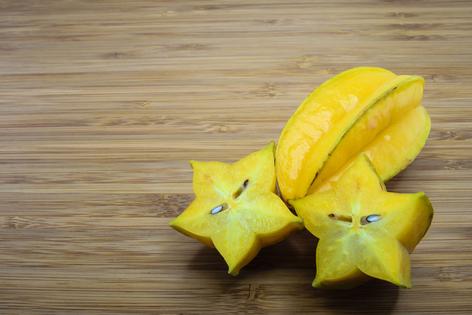Environmental Nutrition: Let star fruit shine
The folklore: The beautiful star fruit - averrhoa carambola - is a tropical fruit that comes from a tree native to the Philippines, Indonesia, Malaysia, India, Bangladesh and Sri Lanka. Today, this fruit - named star fruit because the distinctive ridges running down the fruit's skin form a star shape when sliced - is cultivated throughout many tropical and subtropical areas of the world, such as Florida, Central America and Hawaii. Historically, star fruit was believed to help treat a number of ailments, such as kidney and bladder problems, fevers, eyesores, hangovers, throat pain, tooth sores, colic, indigestion and jaundice. The crushed leaves have been applied as an external treatment for chickenpox and ringworm, the roots have been consumed as an antidote for poison, and the juice has been used to clean and polish metals and remove stains from clothing.
The facts: You can eat the entire star fruit, including the slightly waxy skin that changes from green to bright yellow when ripe. The yellowish flesh is crunchy, firm and extremely juicy, with a flavor reminiscent of citrus fruit and pineapple, and a texture similar to that of grapes. The star fruit is rich in fiber and vitamin C and has a variety of antioxidant phytochemicals, including beta-carotene and lutein.
The findings: Although little clinical research has been conducted on star fruit's health potential, the studies that have been published report some promising benefits, including aiding in stabilizing blood glucose levels, and having anti-inflammatory and anti-bacterial effects. Activity against brain tumor cell growth was observed with an extract from the star fruit stem, while an extract from the leaves was reported to be effective against liver cancer cells, according to preliminary studies. While we're waiting for more research to substantiate star fruit's health rewards, this nutritious fruit is certainly worth starring on your menu.
The finer points: Star fruit, which is in season late spring through early summer, is best consumed shortly after it ripens, when the skin is yellow with little or no trace of green. Fruits picked while still slightly green will ripen at room temperature. Overripe star fruit turns yellow with brown spots, with a milder flavor and soggier consistency. Star fruit can be problematic for people with kidney problems, such as chronic renal failure; consumption (only for those suffering from kidney problems) can cause symptoms of "star fruit intoxication," including persistent hiccups, nausea, vomiting, agitation, insomnia, mental confusion and even death. Although the risk related to these fruits is not completely clear, it is best for people with impaired kidney function to avoid consumption of the fruit. However, star fruit is perfectly safe for those with normal kidney function.
Enjoy the sweet, ripe fruit on its own - sliced into pretty stars - as a snack, dessert, or addition to a fruit platter. You also can add star fruit to salads, salsas, or as a garnish for fish, meat or poultry. Star fruit can be canned, preserved or dried, and its juice is delicious, making an excellent addition to smoothies or iced tea.
Star Fruit Salsa
Serves 6
1 mango, peeled and diced
2 small star fruit, chopped
...continued







